Abstract
In the obese state profound metabolic disturbances exist and it is not known how this disrupted metabolism in obese subjects (body mass index greater than 30) may change their ability to respond to the superimposed, injury-induced stress. Understanding the mechanisms that modify the metabolic parameters in traumatized obese patients is essential in their nutritional assessment and further treatment. We have investigated in 7 obese and 10 nonobese multiple trauma patients, on a whole-body level, the energy metabolism, protein kinetics, and lipolysis in the early catabolic "flow phase" of severe injury when they were receiving maintenance fluids without calories or nitrogen. Traumatized obese patients mobilized relatively more protein and less fat compared with nonobese subjects. A relative block both in lipolysis and fat oxidation is experienced by injured obese patients that results in a shift to preferential use of proteins and carbohydrates. Reduced endogenous protein synthetic efficiency observed in obese patients implies increased protein recycling. Thus obese patients could not effectively use their most abundant fat fuel sources and have to depend on other fuel sources. The nutritional management of obese trauma victims should therefore be tailored towards provision of enough glucose calories to spare protein.
Full text
PDF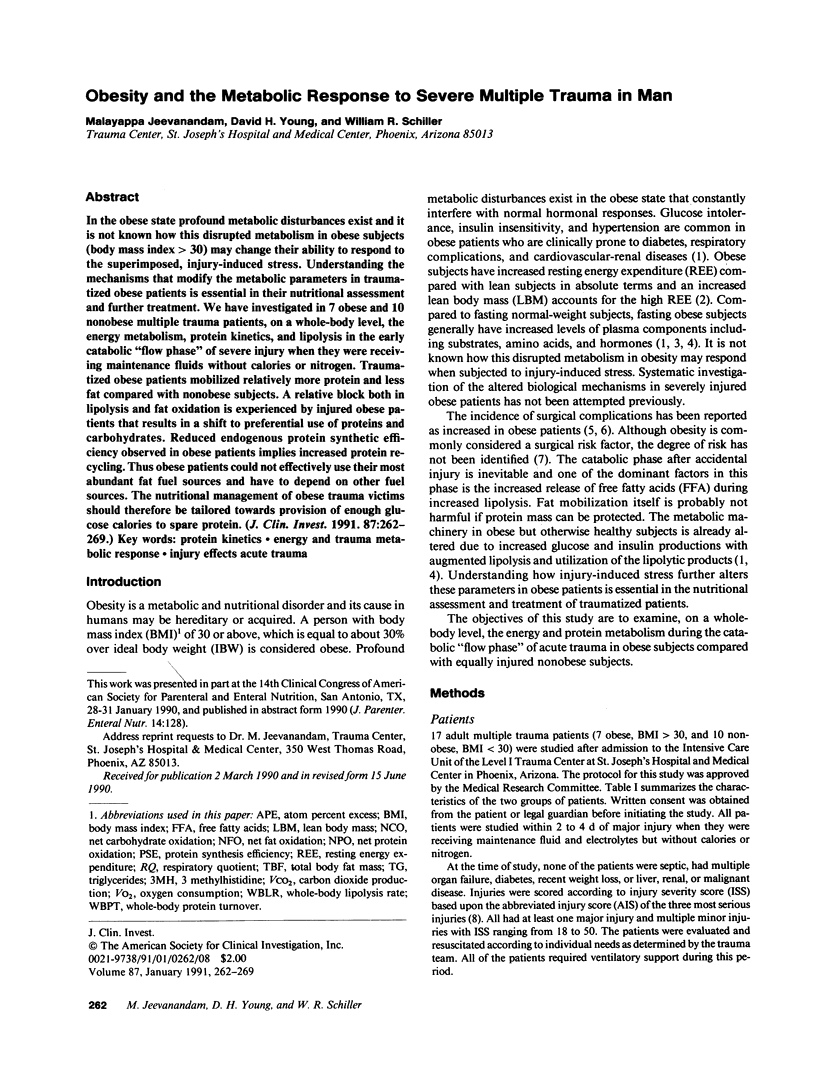
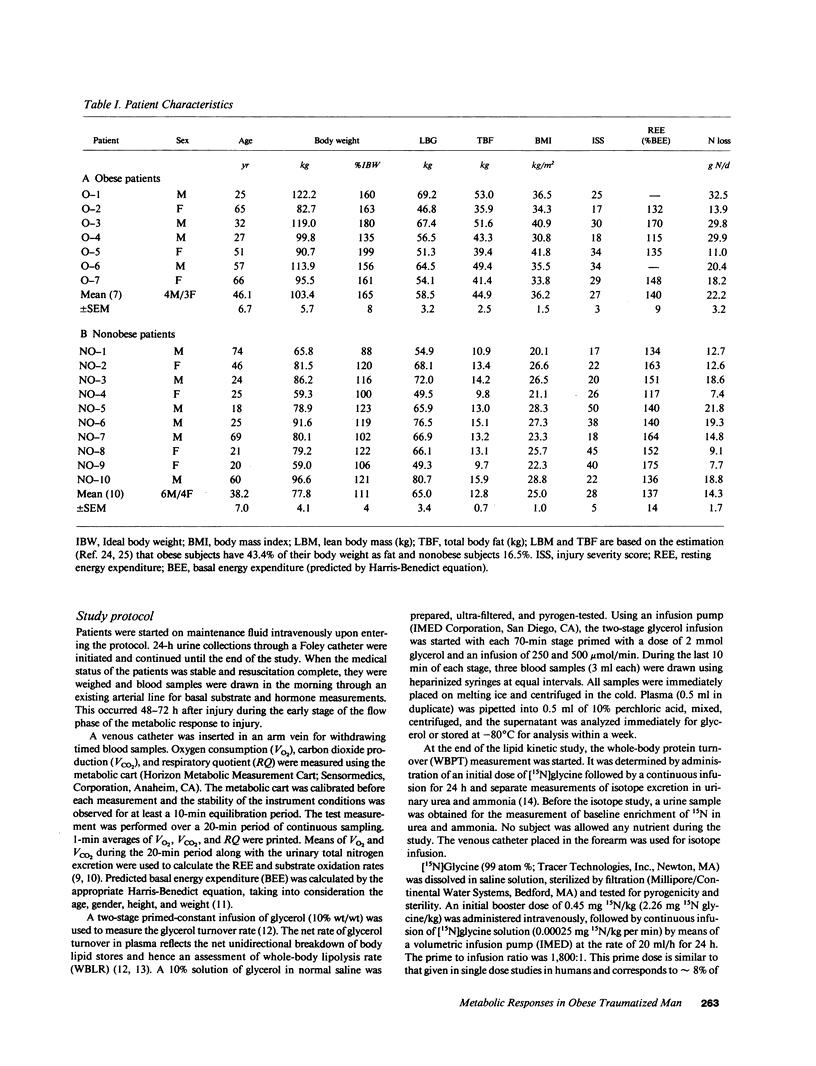
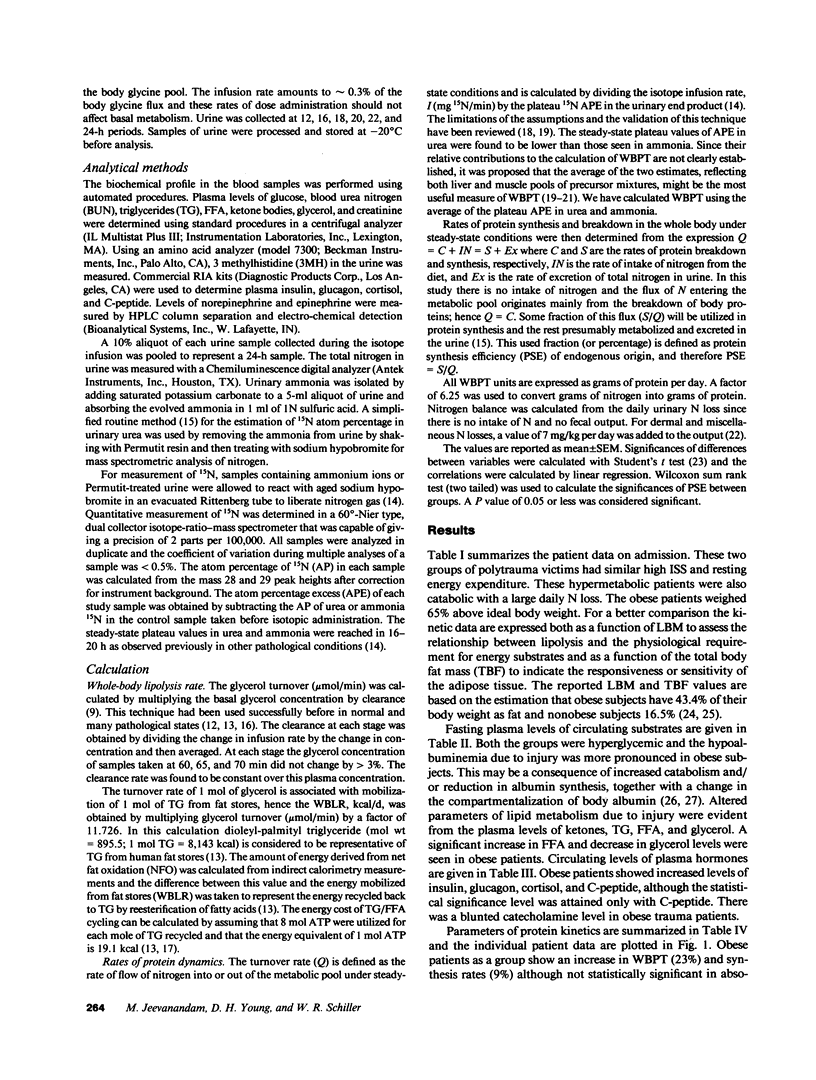
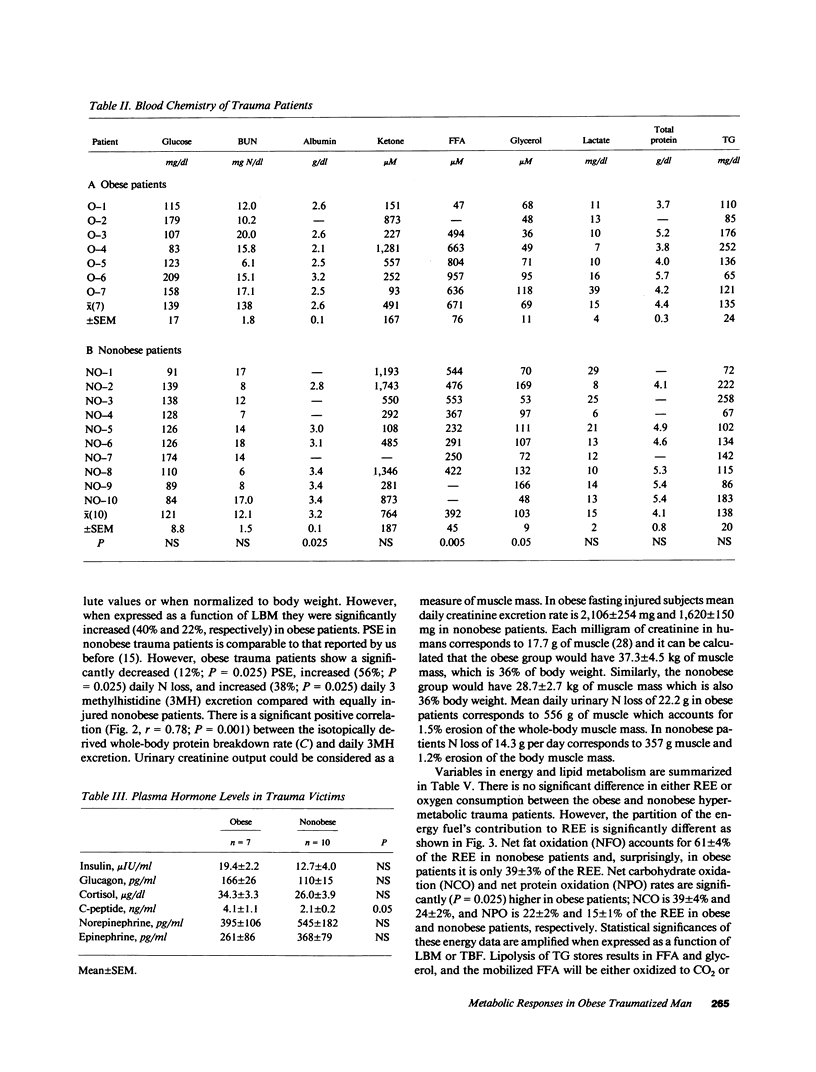
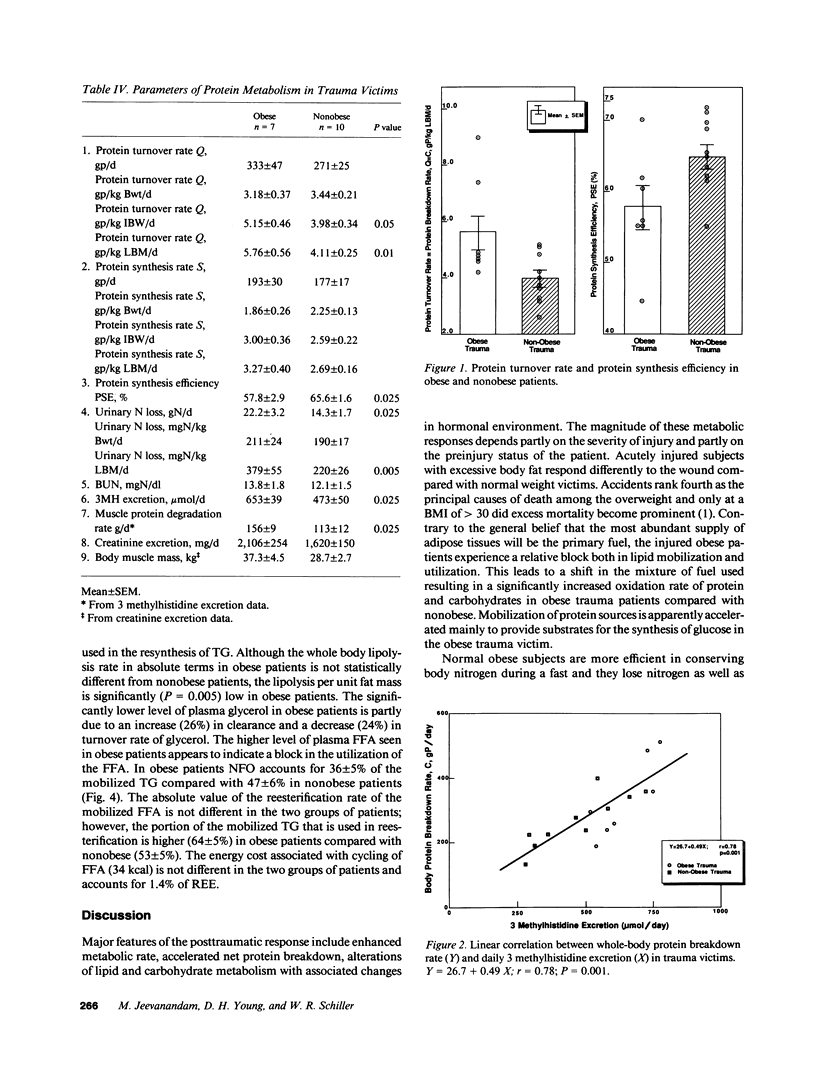
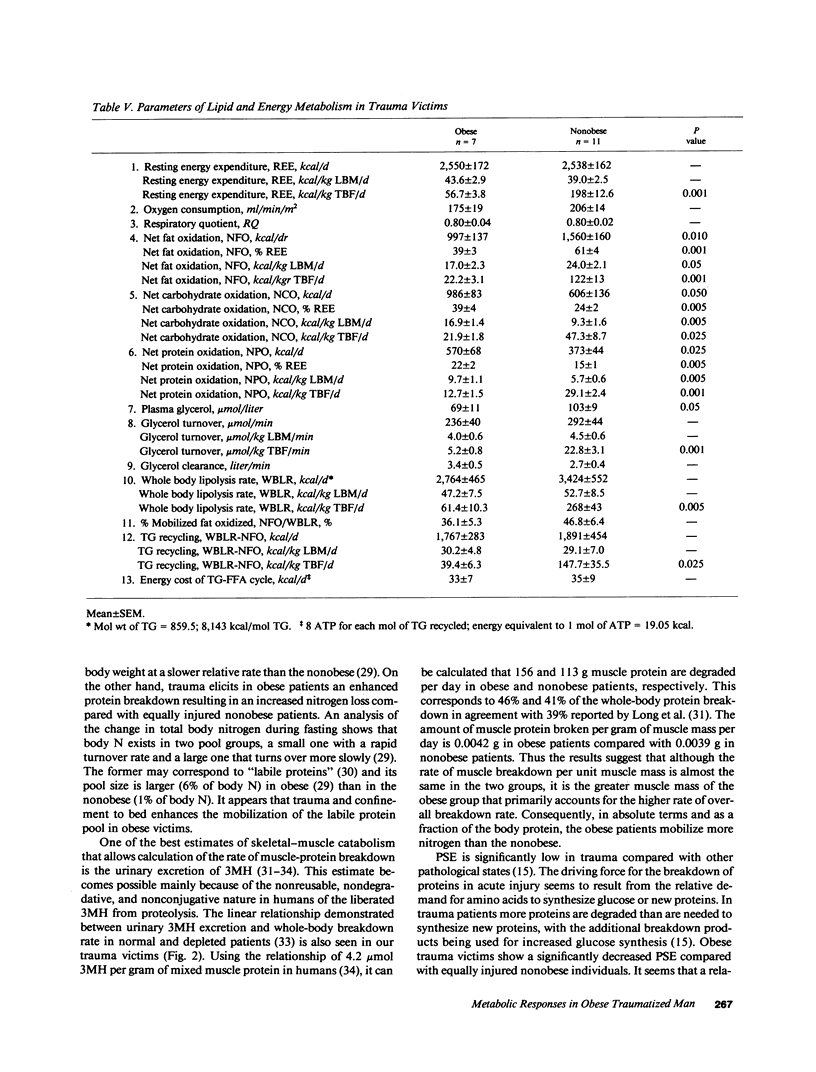
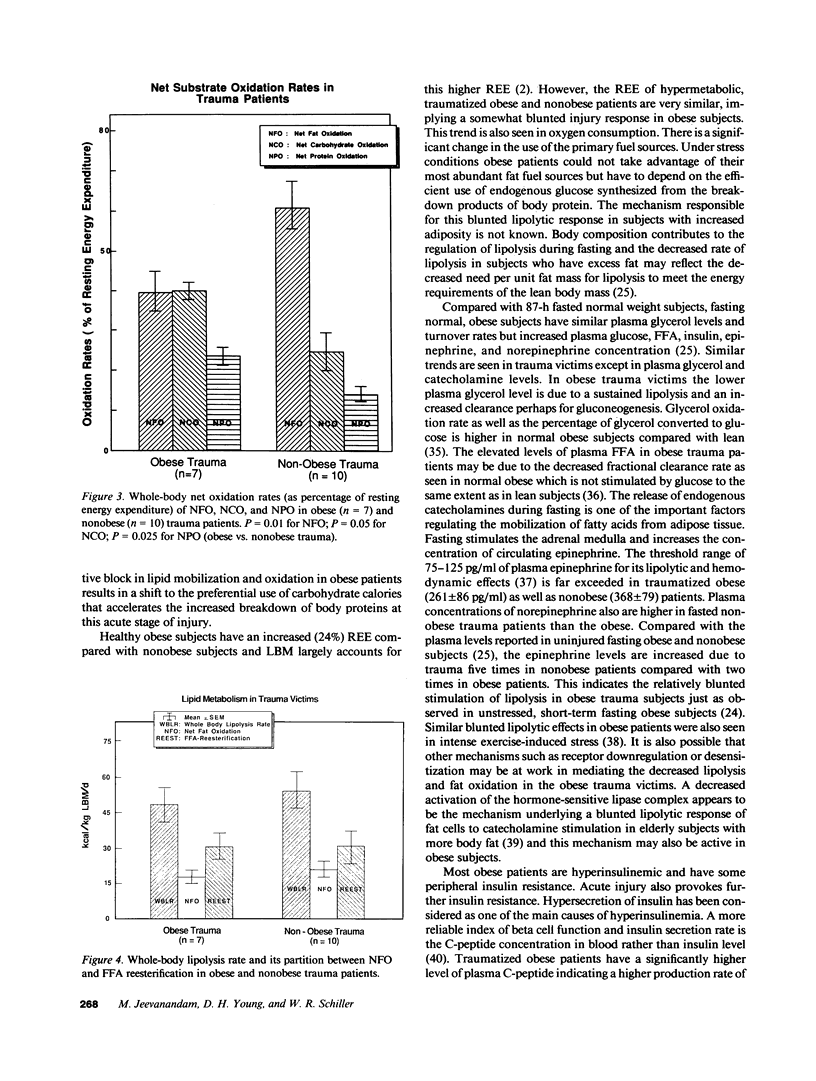
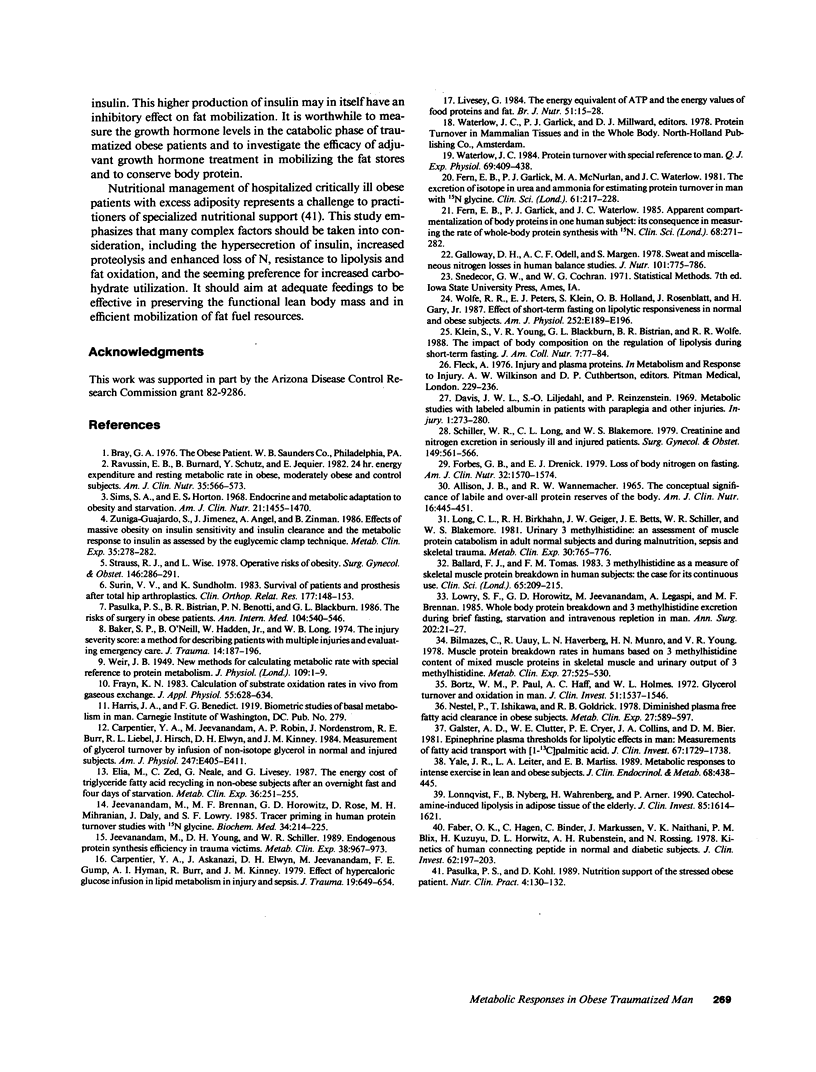
Images in this article
Selected References
These references are in PubMed. This may not be the complete list of references from this article.
- ALLISON J. B., WANNEMACHER R. W., Jr THE CONCEPT AND SIGNIFICANCE OF LABILE AND OVER-ALL PROTEIN RESERVES OF THE BODY. Am J Clin Nutr. 1965 May;16:445–452. doi: 10.1093/ajcn/16.5.445. [DOI] [PubMed] [Google Scholar]
- Baker S. P., O'Neill B., Haddon W., Jr, Long W. B. The injury severity score: a method for describing patients with multiple injuries and evaluating emergency care. J Trauma. 1974 Mar;14(3):187–196. [PubMed] [Google Scholar]
- Ballard F. J., Tomas F. M. 3-Methylhistidine as a measure of skeletal muscle protein breakdown in human subjects: the case for its continued use. Clin Sci (Lond) 1983 Sep;65(3):209–215. doi: 10.1042/cs0650209. [DOI] [PubMed] [Google Scholar]
- Bilmazes C., Uauy R., Haverberg L. N., Munro H. N., Young V. R. Musle protein breakdown rates in humans based on Ntau-methylhistidine (3-methylhistidine) content of mixed proteins in skeletal muscle and urinary output of Ntau-methylhistidine. Metabolism. 1978 May;27(5):525–530. doi: 10.1016/0026-0495(78)90018-5. [DOI] [PubMed] [Google Scholar]
- Bortz W. M., Paul P., Haff A. C., Holmes W. L. Glycerol turnover and oxidation in man. J Clin Invest. 1972 Jun;51(6):1537–1546. doi: 10.1172/JCI106950. [DOI] [PMC free article] [PubMed] [Google Scholar]
- Calloway D. H., Odell A. C., Margen S. Sweat and miscellaneous nitrogen losses in human balance studies. J Nutr. 1971 Jun;101(6):775–786. doi: 10.1093/jn/101.6.775. [DOI] [PubMed] [Google Scholar]
- Carpentier Y. A., Askanazi J., Elwyn D. H., Jeevanandam M., Gump F. E., Hyman A. I., Burr R., Kinney J. M. Effects of hypercaloric glucose infusion on lipid metabolism in injury and sepsis. J Trauma. 1979 Sep;19(9):649–654. doi: 10.1097/00005373-197909000-00002. [DOI] [PubMed] [Google Scholar]
- Elia M., Zed C., Neale G., Livesey G. The energy cost of triglyceride-fatty acid recycling in nonobese subjects after an overnight fast and four days of starvation. Metabolism. 1987 Mar;36(3):251–255. doi: 10.1016/0026-0495(87)90184-3. [DOI] [PubMed] [Google Scholar]
- Faber O. K., Hagen C., Binder C., Markussen J., Naithani V. K., Blix P. M., Kuzuya H., Horwitz D. L., Rubenstein A. H., Rossing N. Kinetics of human connecting peptide in normal and diabetic subjects. J Clin Invest. 1978 Jul;62(1):197–203. doi: 10.1172/JCI109106. [DOI] [PMC free article] [PubMed] [Google Scholar]
- Fern E. B., Garlick P. J., McNurlan M. A., Waterlow J. C. The excretion of isotope in urea and ammonia for estimating protein turnover in man with [15N]glycine. Clin Sci (Lond) 1981 Aug;61(2):217–228. doi: 10.1042/cs0610217. [DOI] [PubMed] [Google Scholar]
- Fern E. B., Garlick P. J., Waterlow J. C. Apparent compartmentation of body nitrogen in one human subject: its consequences in measuring the rate of whole-body protein synthesis with 15N. Clin Sci (Lond) 1985 Mar;68(3):271–282. doi: 10.1042/cs0680271. [DOI] [PubMed] [Google Scholar]
- Forbes G. B., Drenick E. J. Loss of body nitrogen on fasting. Am J Clin Nutr. 1979 Aug;32(8):1570–1574. doi: 10.1093/ajcn/32.8.1570. [DOI] [PubMed] [Google Scholar]
- Frayn K. N. Calculation of substrate oxidation rates in vivo from gaseous exchange. J Appl Physiol Respir Environ Exerc Physiol. 1983 Aug;55(2):628–634. doi: 10.1152/jappl.1983.55.2.628. [DOI] [PubMed] [Google Scholar]
- Galster A. D., Clutter W. E., Cryer P. E., Collins J. A., Bier D. M. Epinephrine plasma thresholds for lipolytic effects in man: measurements of fatty acid transport with [l-13C]palmitic acid. J Clin Invest. 1981 Jun;67(6):1729–1738. doi: 10.1172/JCI110211. [DOI] [PMC free article] [PubMed] [Google Scholar]
- Jeevanandam M., Brennan M. F., Horowitz G. D., Rose D., Mihranian M. H., Daly J., Lowry S. F. Tracer priming in human protein turnover studies with [15N]glycine. Biochem Med. 1985 Oct;34(2):214–225. doi: 10.1016/0006-2944(85)90114-0. [DOI] [PubMed] [Google Scholar]
- Jeevanandam M., Young D. H., Schiller W. R. Endogenous protein-synthesis efficiency in trauma victims. Metabolism. 1989 Oct;38(10):967–973. doi: 10.1016/0026-0495(89)90007-3. [DOI] [PubMed] [Google Scholar]
- Klein S., Young V. R., Blackburn G. L., Bistrian B. R., Wolfe R. R. The impact of body composition on the regulation of lipolysis during short-term fasting. J Am Coll Nutr. 1988 Feb;7(1):77–84. doi: 10.1080/07315724.1988.10720223. [DOI] [PubMed] [Google Scholar]
- Livesey G. The energy equivalents of ATP and the energy values of food proteins and fats. Br J Nutr. 1984 Jan;51(1):15–28. doi: 10.1079/bjn19840005. [DOI] [PubMed] [Google Scholar]
- Long C. L., Birkhahn R. H., Geiger J. W., Betts J. E., Schiller W. R., Blakemore W. S. Urinary excretion of 3-methylhistidine: an assessment of muscle protein catabolism in adult normal subjects and during malnutrition, sepsis, and skeletal trauma. Metabolism. 1981 Aug;30(8):765–776. doi: 10.1016/0026-0495(81)90022-6. [DOI] [PubMed] [Google Scholar]
- Lowry S. F., Horowitz G. D., Jeevanandam M., Legaspi A., Brennan M. F. Whole-body protein breakdown and 3-methylhistidine excretion during brief fasting, starvation, and intravenous repletion in man. Ann Surg. 1985 Jul;202(1):21–27. doi: 10.1097/00000658-198507000-00003. [DOI] [PMC free article] [PubMed] [Google Scholar]
- Lönnqvist F., Nyberg B., Wahrenberg H., Arner P. Catecholamine-induced lipolysis in adipose tissue of the elderly. J Clin Invest. 1990 May;85(5):1614–1621. doi: 10.1172/JCI114612. [DOI] [PMC free article] [PubMed] [Google Scholar]
- Nestel P. J., Ishikawa T., Goldrick R. B. Diminished plasma free fatty acid clearance in obese subjects. Metabolism. 1978 May;27(5):589–597. doi: 10.1016/0026-0495(78)90025-2. [DOI] [PubMed] [Google Scholar]
- Pasulka P. S., Bistrian B. R., Benotti P. N., Blackburn G. L. The risks of surgery in obese patients. Ann Intern Med. 1986 Apr;104(4):540–546. doi: 10.7326/0003-4819-104-4-540. [DOI] [PubMed] [Google Scholar]
- Pasulka P. S., Kohl D. Nutrition support of the stressed obese patient. Nutr Clin Pract. 1989 Aug;4(4):130–132. doi: 10.1177/0115426589004004130. [DOI] [PubMed] [Google Scholar]
- Ravussin E., Burnand B., Schutz Y., Jéquier E. Twenty-four-hour energy expenditure and resting metabolic rate in obese, moderately obese, and control subjects. Am J Clin Nutr. 1982 Mar;35(3):566–573. doi: 10.1093/ajcn/35.3.566. [DOI] [PubMed] [Google Scholar]
- Schiller W. R., Long C. L., Blakemore W. S. Creatinine and nitrogen excretion in seriously ill and injured patients. Surg Gynecol Obstet. 1979 Oct;149(4):561–566. [PubMed] [Google Scholar]
- Sims E. A., Horton E. S. Endocrine and metabolic adaptation to obesity and starvation. Am J Clin Nutr. 1968 Dec;21(12):1455–1470. doi: 10.1093/ajcn/21.12.1455. [DOI] [PubMed] [Google Scholar]
- Strauss R. J., Wise L. Operative risks of obesity. Surg Gynecol Obstet. 1978 Feb;146(2):286–291. [PubMed] [Google Scholar]
- Surin V. V., Sundholm K. Survival of patients and prostheses after total hip arthroplasty. Clin Orthop Relat Res. 1983 Jul-Aug;(177):148–153. [PubMed] [Google Scholar]
- Waterlow J. C. Protein turnover with special reference to man. Q J Exp Physiol. 1984 Jul;69(3):409–438. doi: 10.1113/expphysiol.1984.sp002829. [DOI] [PubMed] [Google Scholar]
- Wolfe R. R., Peters E. J., Klein S., Holland O. B., Rosenblatt J., Gary H., Jr Effect of short-term fasting on lipolytic responsiveness in normal and obese human subjects. Am J Physiol. 1987 Feb;252(2 Pt 1):E189–E196. doi: 10.1152/ajpendo.1987.252.2.E189. [DOI] [PubMed] [Google Scholar]
- Yale J. F., Leiter L. A., Marliss E. B. Metabolic responses to intense exercise in lean and obese subjects. J Clin Endocrinol Metab. 1989 Feb;68(2):438–445. doi: 10.1210/jcem-68-2-438. [DOI] [PubMed] [Google Scholar]
- Zuniga-Guajardo S., Jimenez J., Angel A., Zinman B. Effects of massive obesity on insulin sensitivity and insulin clearance and the metabolic response to insulin as assessed by the euglycemic clamp technique. Metabolism. 1986 Mar;35(3):278–282. doi: 10.1016/0026-0495(86)90214-3. [DOI] [PubMed] [Google Scholar]



